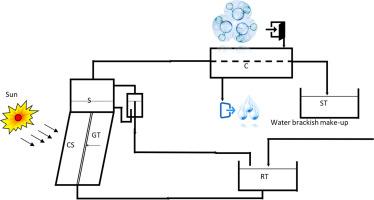Performance evaluation of a cylindrical-parabolic solar distillation unit for brackish water
IF 3.3
Q2 MULTIDISCIPLINARY SCIENCES
引用次数: 0
Abstract
Freshwater scarcity remains a worldwide challenge, and conventional desalination knowledges are frequently expensive and energy-intensive. Solar distillation with concentrator-based systems presents a supportable alternate, yet the consequence of inclination angle on the performance of cylindrical-parabolic concentrators (CPC) has been unsatisfactorily deliberate. This study addresses the need for efficient solar distillation systems by experimentally investigating the performance of a cylindrical-parabolic solar concentrator designed for brackish water desalination to evaluate a CPC solar desalination unit, focusing on thermal behavior and freshwater productivity under different inclination angles. The objective is to evaluate how variations in the inclination angle affect thermal behavior and freshwater yield. An outdoor experimental setup was developed to measure daily water production, temperature distribution, and system efficiency. The system demonstrated an average daily efficiency of approximately 44 %, with water production ranging from 1.9 to 3.3 liters per day, peaking at 1 pm. To better quantify productivity, two performance indicators the Instantaneous Production Factor (FPI) and the Cumulative Production Factor (FPC) were introduced to quantify thermal productivity and efficiency. Comparative analysis with similar solar distillation systems confirmed the effectiveness of the proposed design. The results highlight the potential of CPC-based systems for decentralized freshwater generation in water-scarce regions and emphasize the importance of optimizing inclination angle and thermal design for improved performance.

半咸淡水圆柱-抛物面太阳能蒸馏装置的性能评价
淡水短缺仍然是一个全球性的挑战,而传统的海水淡化技术往往是昂贵和能源密集型的。聚光器太阳能蒸馏是一种可行的选择,但倾角对圆柱形抛物面聚光器性能的影响尚不明确。本研究通过实验研究设计用于咸淡水淡化的圆柱形抛物面太阳能聚光器的性能来评估CPC太阳能淡化装置,重点研究了不同倾角下的热行为和淡水生产力,从而解决了对高效太阳能蒸馏系统的需求。目的是评估倾角的变化如何影响热行为和淡水产量。开发了一个室外实验装置来测量每天的产水量、温度分布和系统效率。该系统的平均日效率约为44%,每天的产水量为1.9至3.3升,在下午1点达到峰值。为了更好地量化产能,引入了瞬时生产因子(FPI)和累积生产因子(FPC)两个性能指标来量化热产能和效率。与同类太阳能蒸馏系统的对比分析证实了该设计的有效性。研究结果强调了基于cpc的系统在缺水地区分散淡水生产的潜力,并强调了优化倾角和热设计以提高性能的重要性。
本文章由计算机程序翻译,如有差异,请以英文原文为准。
求助全文
约1分钟内获得全文
求助全文
来源期刊

Scientific African
Multidisciplinary-Multidisciplinary
CiteScore
5.60
自引率
3.40%
发文量
332
审稿时长
10 weeks
 求助内容:
求助内容: 应助结果提醒方式:
应助结果提醒方式:


